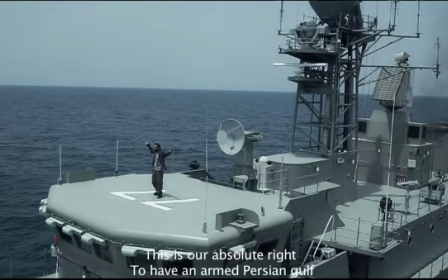The Iran nuclear agreement in a nutshell

1. Iran will keep its enrichment capacity at no more than 5060 IR-1 centrifuge machines in their current configurations in currently operating units at the Natanz Fuel Enrichment Plant (FEP) for 10 years.
2. For a 15-year period, Iran will keep its uranium stockpile under 300 kg of up to 3.67 percent enriched uranium hexafluoride (UF6) or the equivalent in other chemical forms. The excess quantities are to be sold based on international prices and delivered to the international buyer in return for natural uranium delivered to Iran, or are to be down-blended to natural uranium level.
3. For 15 years, Iran will permit the IAEA to implement continuous monitoring, including through containment and surveillance measures (used to monitor declared activities and detect undeclared activities and equipment tampering), as necessary, to verify that stored centrifuges and infrastructure remain in storage, and are only used to replace failed or damaged centrifuges.
4. Iran will convert the Fordow facility into a nuclear, physics and technology centre. 1044 IR-1 centrifuges will remain in one wing at Fordow, one third of which will not be fed uranium and will be used for stable isotope production, used in many medical and other research fields. The other two thirds of the centrifuges will remain idle. All other centrifuges and enrichment-related infrastructure will be removed and stored under IAEA continuous monitoring.
5. On “Adoption Day” 90 days after a UN Security Council resolution or at an earlier date by mutual consent of all Joint Comprehensive Action Plan (JCPOA) participants, at which point this comes into effect, JCPOA participants will make necessary arrangements and preparations, including legal and administrative preparations, for the implementation of their JCPOA commitments. The EU and its member states will adopt an EU regulation terminating all provisions implementing nuclear-related economic and financial EU sanctions simultaneously with the IAEA-verified implementation by Iran of agreed nuclear-related measures. The United States will issue waivers, to take effect upon "Implementation Day," ceasing the application of the statutory nuclear-related sanctions.
6. On “Implementation Day”, to occur upon the IAEA-verified implementation by Iran of agreed nuclear-related measures, the EU will take the actions to terminate or amend its regulations so as to end all nuclear-related sanctions. The United States will take action to cease the application of nuclear-related sanctions. Both EU and US will remove individuals and entities from their respective lists of targets of nuclear-related sanctions. Sanctions provisions in past UN Security Council resolutions will also be terminated as of that date under a new Security Council resolution.
7. Iran will fully implement the "Roadmap for Clarification of Past and Present Outstanding Issues" agreed with the IAEA, to address past and present issues of concern relating to its nuclear programme raised in the annex to the IAEA report of 8 November 2011 (GOV/2011/65). The implementation will be completed by 15 October 2015. The IAEA director general will provide the final assessment of those outstanding issues to the board of governors by 15 December 2015. The E3+3 [US, UK, France, Germany, Russia and China] as members of the board of governors, will then submit a resolution to the board of governors to close the issue.
8. The E3/EU+3 will take adequate administrative and regulatory measures to ensure clarity and effectiveness with respect to the lifting of sanctions under this joint action plan. The EU and its member states as well as the United States will issue relevant guidelines and make publicly accessible statements on the details of sanctions or restrictive measures that have been lifted under the JCPOA. The EU and its Member States and the United States commit to consult with Iran regarding the content of such guidelines and statements, on a regular basis and whenever appropriate.
9. If Iran or any or all of E3/EU+3 believes the other party is not meeting commitments under this JCPOA, they could refer the issue to the Joint Commission for resolution. After 15 days, any participant could refer the issue to ministers of foreign affairs, and failing resolution by them, to a three-member advisory board, one of whose members would be independent of the two sides. If the issue remains unresolved, the complaining participant could treat the unresolved issue as grounds to cease performing its commitments under this JCPOA in whole or in part and/or notify the UN Security Council that it believes the issue constitutes significant non-performance. Within 30 days of the notification, the provisions of the old UN Security Council resolutions would be re-imposed, unless the UN Security Council decides otherwise. Iran has stated that, if the other parties to the agreement re-impose sanctions, Iran would cease to implement its commitments under the agreement.
10. If the IAEA has concerns regarding undeclared nuclear materials or at undeclared sites, and Iran’s explanations do not resolve the IAEA’s concerns, the agency may request access to such locations. Iran may propose alternative means of resolving the IAEA’s concerns. If the IAEA concerns remain after the implementation of the alternative arrangements agreed by Iran and the IAEA, or if the two sides are unable to reach satisfactory arrangements within 14 days of the IAEA’s original request for access, Iran would consult with the members of the Joint Commission on resolving IAEA’s concerns through an agreement between Iran and the IAEA. In the absence of an agreement, the members of the Joint Commission would decide within seven days by a vote of five of its eight members on a means to resolve the issue.
Stay informed with MEE's newsletters
Sign up to get the latest alerts, insights and analysis, starting with Turkey Unpacked
Middle East Eye delivers independent and unrivalled coverage and analysis of the Middle East, North Africa and beyond. To learn more about republishing this content and the associated fees, please fill out this form. More about MEE can be found here.




